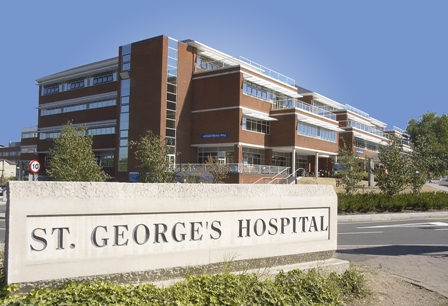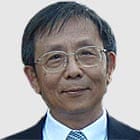History of the Renal Unit at St George’s

The renal care at St George's has been active since the 1970s. Since then the service has changed dramatically from a single non-renal specialist consultant to the service today with multiple consultant nephrologists, transplant surgeons, over 100 staff and offering dialysis and transplantation services across SW London, Surrey, Sussex and Hampshire.
Initial renal & dialysis services
In the early 1960s, individual London Teaching Hospitals were consulted on their views on taking on the new treatment of haemodialysis. The Royal Free Hospital started treating patients in 1963 followed by Charing Cross Hospital in 1964. Clinicians at St George's Hospital, then at Hyde Park Corner, declined the offer.
In 1973, a Consultant Physician with a background in Renal disease, was appointed to St George's Hospital; he left in 1979. After a gap of almost a year with no Renal Physician, Dr John Eastwood was appointed as the first Consultant Renal Physician. His appointment on July 1st 1980 coincided with the final closure of St George's Hospital at Hyde Park Corner on June 29th 1980 when the last patients were transferred to the Tooting site. Renal in-patient beds were provided at St James's Hospital, Balham and remained there until St James's closed in August 1988. Coincidentally, in the same month the first Specialist Nephrologist in Training [Senior Registrar level] was appointed. On the closure of St James's, all renal facilities and staff moved to St George's Hospital, Tooting.
Once all renal facilities were on the single site at St George's it was possible to develop facilities for haemodialysis and peritoneal dialysis. The first patient was established on CAPD in October 1989, and the first on haemodialysis in August 1990. Patients with Acute renal failure [AKI: acute kidney injury] were treated in collaboration with Professor David Bennett in the main Intensive Care Unit.
Developments in Renal Medicine and Transplantation in London and the South-East
Specialty Reviews in 6 disciplines in the South-East were undertaken in 1993 - Renal Services [in essence transplantation], Cancer Services, Cardio-Thoracic Surgery, and Neurosurgery among others. The Review of Renal Services was necessary because in the area consisting of London, Essex, Kent, Surrey and Sussex there were no fewer than 14 transplant units doing about 500 transplants a year, i.e. about 35 per unit; some units did under 20 a year. The lack of activity in the majority of units meant that it was not possible to train budding transplant surgeons. At that time, most if not all transplant surgeons came were trained in Oxford and Cambridge.
The intention was to create 4 transplant centres each doing 125 transplants a year. In the event, there were finally 5 units based on the 5 enlarged Medical schools - Imperial/Hammersmith/St Mary's Paddington, University College/Royal Free, Queen Mary's/Royal London, King's College/Guy's and St George's University/Hospital.
Developments at St George's
In the early 1990s, the Chairman of St George's Trust, Dr Elizabeth Vallance, and her board made the development of Renal Services a priority. In April 1994, Dr Tony Wing's Consultant Nephrology post was transferred from St Thomas's Hospital to St George's, and in August the first two dedicated Renal SHOs were appointed Crucially, in September, Mr René Chang was appointed as the first Renal transplant surgeon at St George's, with Mr Mick Bewick from King's College as his colleague. The first cadaveric transplant took place in September 1994.
Transplantation Services by René Chang
 Mr Chang was very aware of the very competitive environment he was working in. All transplant units were set up 10 or 20 years previously. To be successful required something to be done differently.
Mr Chang was very aware of the very competitive environment he was working in. All transplant units were set up 10 or 20 years previously. To be successful required something to be done differently.
From 1995 until his retirement in 2009 he organised an annual public audit – anyone who wished was free to attend - patients, hospital staff and management. This was a new approach to audit in the NHS – an openness that had not traditionally been present. It was important that there would good results, he started using FK506 – Tacrolimus. St George’s was the first hospital in the UK to use this new approach to immunosuppressive therapy. Mr Chang expanded the transplant list by inviting the Dulwich Hospital team led by Mr Bewick and Dr Sue Snowden to join the St George’s team in 1995. Unbeknown to Mr Chang, Mr Bewick had trained at the old St George's at Hyde Park Corner.
During the 1990’s there was an acute shortage of trainee surgeons in the speciality of transplantation in London. Mr Chang set up an SHO training programme for transplantation surgical trainees at the first opportunity he had. He also recruited consultant surgeons from France and the Czech Republic bringing with them specialist skills in access and laparoscopic surgery. The advance in laparoscopic surgery was particularly relevant as UK Transplant were at that time trying to increase the number of live donor transplants.
To encourage research and development in the field of renal transplantation he also established an animal laboratory to look at improving methods of organ preservation and improving viability.
During his last year at St George’s the unit performed the highest number of kidney transplants ever at 157. But it was not just about the numbers of transplants performed but also the success rate. For four consecutive years there was not a single transplant related death and the success was 100%.

